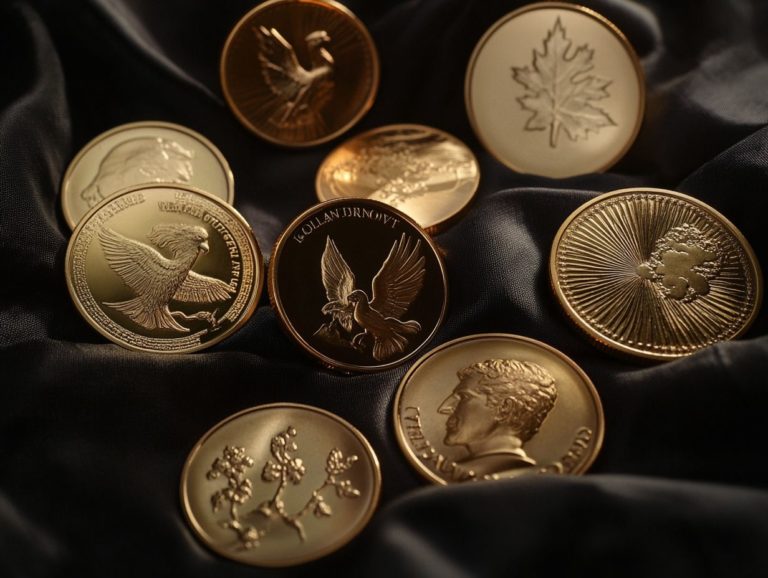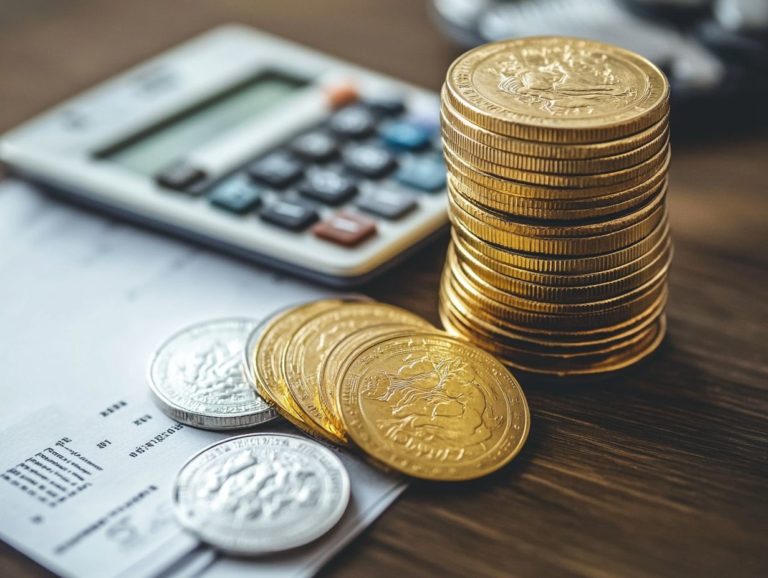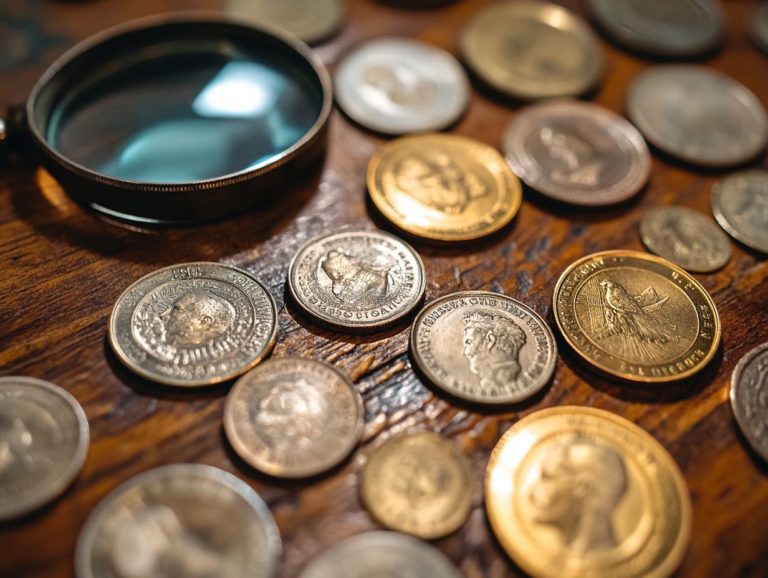What are the Key Indicators for Gold Investment?
Gold investment has been a safe haven for those wanting to diversify their portfolios and protect their wealth.
Understanding the factors that influence gold prices is vital for any investment strategy. This article explores the essence of gold investment, including economic and political influences that make it a compelling choice.
You will also find insights into various investment strategies, essential indicators to monitor, and a balanced look at the potential risks and rewards associated with this timeless asset.
Join us as you discover how gold can protect your wealth!
Contents
- Key Takeaways:
- Factors Affecting Gold Prices
- Why Invest in Gold?
- How to Invest in Gold
- Key Indicators for Gold Investment
- Risks and Rewards of Gold Investment
- Frequently Asked Questions
- Key Indicators to Watch for Gold Investment Success
- How do Supply and Demand Affect Gold Investment?
- What Impact do Interest Rates Have on Gold Investment?
- How Does Inflation Affect Gold Investment?
- Why is Global Economic and Political Stability Important for Gold Investment?
- What Role do Market Trends Play in Gold Investment?
Key Takeaways:
- Gold investment is a popular and stable option influenced by economic and political factors.
- Gold can protect you against inflation and help diversify your investments.
- Before investing in gold, consider factors such as market trends, supply and demand, and geopolitical events.
What is Gold Investment?
Gold investment is your pathway to preserving wealth and generating returns by buying and holding this timeless asset. As a highly regarded asset that can easily be bought or sold, gold has drawn interest for centuries, thanks to its intrinsic value and its status as a precious metal that thrives in various economic climates.
By investing in gold, you can effectively hedge against inflation and economic uncertainty, which is why it remains a favored choice among investors and financial institutions, including central banks and Exchange Traded Funds (ETFs).
Historically, gold has been synonymous with wealth and prosperity, often serving as currency and as a benchmark for monetary systems. Today, you have the opportunity to diversify your portfolio through various forms of gold investment. This includes physical gold think coins and bars or gold-backed Exchange Traded Funds (ETFs) like SPDR Gold Shares (GLD).
For those with a penchant for speculation, futures contracts offer a way to invest based on anticipated price movements. According to the World Gold Council, the interplay of gold supply and demand significantly shapes market trends, with shifts in consumer preferences and geopolitical factors further influencing its value. Understanding these dynamics is essential for anyone seeking to navigate the complexities of gold investments.
Factors Affecting Gold Prices
The price of gold is shaped by a multitude of factors that you should consider, from economic and political conditions to fluctuations in currency values.
Changes in the demand for gold, whether as an investment or a store of value, also contribute significantly to its price dynamics. Pay attention to the activities of central banks, especially their gold reserves and buying patterns, as these can heavily influence market conditions.
Furthermore, inflation and economic uncertainty often lead you to consider gold as a hedge, which can also impact its overall value.
Economic and Political Factors
Economic and political factors significantly influence gold prices, creating fluctuations that you must navigate with care. During times of economic uncertainty think high inflation or financial crises demand for gold often increases as it is seen as a safe haven. In response, central banks adjust their gold reserves to align with this shifting demand.
Key indicators, such as GDP growth rates and interest levels, offer you valuable insights into investor sentiment and market positioning. For example, in Uzbekistan, rising gold production driven by strategic investments has strengthened its economic framework, thereby impacting global supply dynamics. Understanding the top precious metals for investment can also provide further context on these trends.
On the flip side, in Qatar, variations in political stability and regional tensions can alter gold consumption patterns, leading to heightened imports. These case studies illustrate how national policies and changes in production capacities not only influence local economies but also play a vital role in shaping global gold demand.
By staying attuned to these trends, you ll be in a prime position to make well-informed investment decisions.
Why Invest in Gold?
Investing in gold presents a wealth of advantages, making it an appealing choice for both seasoned investors and those just beginning their money management.
As a hedge against inflation and economic uncertainty, gold stands as a dependable store of value, frequently outshining other assets during financial turmoil.
Gold has intrinsic value due to its demand in jewelry and technology, reinforcing its crucial role in well-rounded investment portfolios.
Benefits and Advantages
Investing in gold offers numerous benefits, standing out as one of the most reliable easily accessible assets available to you.
Gold is especially attractive during economic uncertainty when traditional currencies may stumble.
Its liquidity allows for quick conversion into cash, making it perfect for moments when immediate access to funds is essential.
You ll appreciate gold s portability, as it can be easily transported, whether you re dealing in small quantities or larger holdings.
Historically, gold has shown remarkable stability and often outpaces inflationary trends linked to fiat currencies, reinforcing its reputation as a safe haven.
Significant demand from sectors like jewelry and technology enhances its market strength, showcasing its multifaceted utility beyond mere investment.
How to Invest in Gold
Investing in gold offers you a range of exciting ways to invest in this valuable metal, tailored to your unique preferences and financial aspirations.
Whether you choose to acquire physical gold like coins and bullion or opt for gold ETFs (Exchange-Traded Funds, which let you invest in gold without owning the physical metal), you have various options.
Each method comes with its own set of advantages and considerations, allowing you to select the approach that aligns best with your investment strategy.
Different Methods and Strategies
When considering how to invest in gold, several methods and strategies present themselves, each offering its unique blend of benefits and risks.
Opting for physical gold, such as coins and bars, grants you tangible ownership, while gold ETFs provide easier liquidity and fewer concerns about storage.
If you find yourself drawn to the allure of possessing a real asset, physical gold is undeniably enticing. It offers a sense of security that intangible investments often lack.
On the other hand, if financial flexibility is what you seek, gold ETFs might be more appealing, closely tracking gold prices without the hassle of managing a physical asset.
Mining stocks present another intriguing option, potentially delivering higher returns, but they come with added risks tied to company performance and market fluctuations.
Achieving diversification within your gold investments means balancing these different avenues. Consider market conditions and factors influencing gold supply, such as geopolitical events and shifts in currency value.
By grasping these dynamics, you can navigate this complex landscape with greater confidence and effectiveness.
Key Indicators for Gold Investment
Key indicators for gold investment offer invaluable insights as you navigate the intricate landscape of the gold market.
By understanding factors such as gold demand, prevailing market conditions, and the effects of financial crises, you can make informed investment decisions that greatly influence your success.
Factors to Consider Before Investing
Before diving into investing in gold, there are several factors to consider to ensure your decisions align with your financial goals and current market conditions.
Understand the broader economic landscape, monitor inflation trends, and assess the dynamics of gold production and supply that could sway prices.
Timing is everything; don’t miss out on monitoring market fluctuations and geopolitical events that may influence gold demand.
Evaluate different storage solutions for your physical gold, as security and accessibility can significantly impact your overall investment experience.
As economic uncertainty persists, assessing gold production trends becomes crucial in identifying potential risks related to supply disruptions or rising mining costs.
By weighing these aspects, you can make a more informed decision about stepping into the gold market.
Risks and Rewards of Gold Investment
The realm of gold investment presents a unique blend of risks and rewards that you should evaluate thoroughly. While gold is seen as a reliable investment during crises, market conditions can introduce considerable ups and downs in prices.
This emphasizes the need to assess both potential gains and possible losses associated with your investment.
Potential Gains and Losses
Investing in gold can unlock exciting opportunities for potential gains, especially during times of financial crisis or economic instability. However, this path is not without risks, as market volatility can lead to unexpected losses. The price of gold fluctuates based on various factors that can impact your returns.
For example, during the 2008 financial crisis, gold prices soared as investors flocked to reliable investments, eventually exceeding $1,800 an ounce. Conversely, during periods of economic recovery like in 2013 gold dropped nearly 30% from its previous highs. Global events, including geopolitical tensions and inflation rates, significantly shape these price movements.
To successfully navigate this ever-changing landscape, stay informed about economic indicators, diversify your portfolio, and strategically time your purchases or sales. This approach helps you reduce risks while positioning yourself to capitalize on potential price surges. To understand more about this, consider learning about what the minimum investment for gold is. Don’t miss out on potential gold price surges—stay informed and act wisely!
Frequently Asked Questions
Key Indicators to Watch for Gold Investment Success
Key indicators for gold investment include supply and demand, interest rates, inflation, global economic and political stability, and market trends.
How do Supply and Demand Affect Gold Investment?
Supply and demand play a crucial role in gold’s performance as an investment. When demand for gold is high, its price tends to rise, and vice versa. This is because gold has limited supply, and high demand can drive up its value.
What Impact do Interest Rates Have on Gold Investment?
Interest rates significantly impact gold investment. When interest rates are low, investors may turn to gold as a safe haven asset, increasing its demand and price. Conversely, high interest rates may lead to a decrease in gold’s demand and price.
How Does Inflation Affect Gold Investment?
Inflation, or the general increase in prices, can also influence gold investment. As inflation rises, the value of fiat currency decreases, making gold a more attractive investment to protect against inflation. This can drive up the demand and price of gold.
Why is Global Economic and Political Stability Important for Gold Investment?
Global economic and political stability influences gold’s performance as an investment. In times of economic or political uncertainty, investors may seek refuge in gold, driving up its demand and price. During stable economic and political conditions, the demand for gold may decrease.
What Role do Market Trends Play in Gold Investment?
Market trends, such as the performance of other assets and overall market sentiment, also affect gold investment. For instance, during a stock market crash, investors may turn to gold as a safe haven, increasing its demand and price. However, if other assets perform well, the demand for gold may decline.
Consider incorporating gold investment into your financial strategy for a balanced portfolio.















